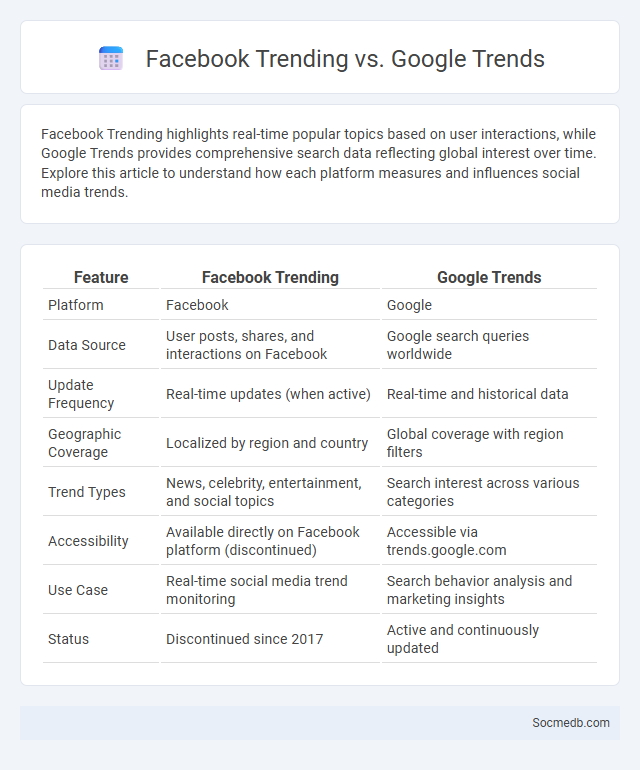
Photo illustration: Facebook Trending vs Google Trends
Facebook Trending highlights real-time popular topics based on user interactions, while Google Trends provides comprehensive search data reflecting global interest over time. Explore this article to understand how each platform measures and influences social media trends.
Table of Comparison
| Feature | Facebook Trending | Google Trends |
|---|---|---|
| Platform | ||
| Data Source | User posts, shares, and interactions on Facebook | Google search queries worldwide |
| Update Frequency | Real-time updates (when active) | Real-time and historical data |
| Geographic Coverage | Localized by region and country | Global coverage with region filters |
| Trend Types | News, celebrity, entertainment, and social topics | Search interest across various categories |
| Accessibility | Available directly on Facebook platform (discontinued) | Accessible via trends.google.com |
| Use Case | Real-time social media trend monitoring | Search behavior analysis and marketing insights |
| Status | Discontinued since 2017 | Active and continuously updated |
Overview: Understanding Facebook Trending, Google Trends, and General Trending
Facebook Trending highlights popular topics and news based on user interactions, providing real-time insight into what is capturing audience attention. Google Trends analyzes search query data to reveal the relative popularity and geographic distribution of specific terms over time. General trending topics aggregate data from multiple platforms to identify widespread interests, enabling marketers and researchers to track emerging patterns and audience behavior efficiently.
Key Features of Facebook Trending
Facebook Trending highlights real-time popular topics by analyzing user interactions, shares, and news publications across its platform. It categorizes trending subjects into distinct segments such as politics, entertainment, sports, and technology to enhance user engagement. The feature leverages algorithmic analysis and natural language processing to present relevant and timely content tailored to individual user preferences.
Core Functions of Google Trends
Google Trends offers powerful insights by tracking search interest over time, allowing you to identify trending topics and popular keywords related to social media. Its core functions include real-time data analysis, geographic breakdowns, and category-specific filters that help you understand audience behavior and content performance. Utilizing these features empowers your social media strategy with data-driven decisions and enhances content relevance.
What Does "Trending" Mean Across Platforms?
Trending on social media refers to the rapid rise in popularity of specific topics, hashtags, or content across multiple platforms such as Twitter, Instagram, TikTok, and Facebook. These trends are identified by algorithms analyzing user engagement metrics like shares, likes, comments, and search frequency, reflecting real-time public interest or viral moments. Understanding what's trending helps you stay relevant and connect with the broader online conversation in your niche.
Data Sources: Facebook vs Google vs General Trends
Facebook provides rich social media data through user-generated content, advertising metrics, and engagement analytics, offering granular insights into audience behavior and preferences. Google aggregates vast amounts of data from search queries, YouTube interactions, and Google Analytics, enabling comprehensive trend identification and user intent analysis. Your marketing strategy benefits by combining Facebook's demographic targeting with Google's expansive search and video data to capture both social engagement and broader online trends effectively.
Audience Engagement: Social vs Search vs Viral Trends
Audience engagement on social media varies significantly between social, search, and viral trends, with social interactions driven by personalized content and community building fostering deeper user connections. Search trends prioritize keyword relevance and user intent, optimizing content discoverability and direct responses to queries, thereby enhancing targeted engagement. Viral trends rely on rapid content sharing and emotional resonance, generating high spikes in interactions but often lacking sustained audience loyalty or long-term engagement.
Real-Time Updates: Speed and Accuracy Comparison
Real-time updates on social media platforms like Twitter and Facebook deliver information at lightning speed, though the accuracy can vary widely. Twitter's design promotes rapid dissemination of breaking news, making it a go-to source for immediate updates, while Facebook tends to prioritize content verification and context, enhancing reliability. Your ability to stay informed depends on balancing the speed of Twitter's real-time alerts with Facebook's emphasis on accuracy.
Use Cases: When to Use Each Trending Tool
Social media platforms like Instagram, TikTok, and LinkedIn each serve unique purposes for different use cases, maximizing engagement and reach. Instagram excels in visual storytelling for brands and influencers, TikTok is ideal for viral short-form videos targeting younger audiences, and LinkedIn suits professional networking and B2B marketing. Understanding when to use each trending tool helps you tailor your content strategy effectively to meet your marketing goals.
Limitations and Challenges of Trending Platforms
Trending social media platforms face significant limitations including algorithmic bias that can restrict content diversity and amplify echo chambers, impacting user experience and information accuracy. User privacy concerns and data security vulnerabilities remain critical challenges, with frequent breaches undermining trust and platform integrity. Moreover, rapid content cycles often promote misinformation and superficial engagement, hindering meaningful interactions and long-term community building.
Choosing the Right Trend Tracker for Your Needs
Selecting the right trend tracker for social media requires evaluating features such as real-time analytics, audience insights, and platform compatibility to ensure accurate data monitoring. Tools like Brandwatch, Sprout Social, and BuzzSumo offer specialized trend tracking capabilities tailored to different marketing objectives and budget constraints. Prioritizing a trend tracker that integrates seamlessly with existing social media management workflows enhances decision-making and campaign effectiveness.
 socmedb.com
socmedb.com